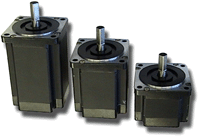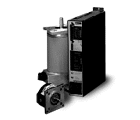AMAZON multi-meters discounts AMAZON oscilloscope discounts
Stepper Motor -- a formal, engineering definition:
A stepping motor is an electromagnetic incremental-motion actuator which converts digital pulse inputs to analog output motion. The device is also termed a step motor. When energized in a programmed manner by a voltage and current input, usually dc, a step motor can index in angular or linear increments. With proper control, the output steps are always equal in number to the input command pulses. Each pulse advances the rotor shaft one step increment and latches it magnetically at the precise point to which it's stepped. Advances in digital computers and particularly microcomputers revolutionized the controls of step motors. These motors are found in many industrial control systems, and large numbers are used in computer peripheral equipment, such as printers, tape drives, capstan drives, and memory-access mechanisms. Step motors are also used in numerical control systems, machine-tool controls, process control, and many systems in the aerospace industry.
There are many types of step motors. Most of the widely used ones can be classified as variable-reluctance, permanent-magnet, or hybrid permanent-magnet types. A variable-reluctance step motor is simple to construct and has low efficiency. The permanent-magnet types are more complex to construct and have a higher efficiency.
Stepper motors allow for precise positioning and speed control without the need for sensors feedback. Simply put, the operation of a stepper motor allows the shaft to move a precise number of degrees each time a pulse of electricity is sent to the motor. Since the shaft of the motor moves only the number of degrees that it was designed for when each pulse is delivered, one can control the pulses which are sent and control the positioning and speed. The rotor of the motor produces torque from the interaction between the magnetic field in the stator and rotor. The strength of the magnetic fields is proportional to the amount of current sent to the stator and the number of turns in the windings.
The image below shows a few, typical stepper motors and their controllers
(drives). These motors are available for a wide variety of motion-control
applications such as single- and multiple-axis control for robots, or
machine tools such as mills and lathes. Smaller motors are used in printers
or some types of computer disc drives.
 |
 |
HOME | NEXT: Types of Stepper Motors